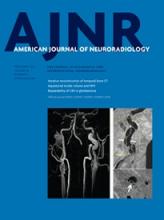Abstract
BACKGROUND AND PURPOSE: Aneurysm progression and rupture is thought to be governed by progressive degradation and weakening of the wall in response to abnormal hemodynamics. Our goal was to investigate the relationship between the intra-aneurysmal hemodynamic conditions and wall mechanical properties in human aneurysms.
MATERIALS AND METHODS: A total of 8 unruptured aneurysms were analyzed. Computational fluid dynamics models were constructed from preoperative 3D rotational angiography images. The aneurysms were clipped, and the domes were resected and mechanically tested to failure with a uniaxial testing system under multiphoton microscopy. Linear regression analysis was performed to explore possible correlations between hemodynamic quantities and the failure characteristics and stiffness of the wall.
RESULTS: The ultimate strain was correlated negatively to aneurysm inflow rate (P = .021), mean velocity (P = .025), and mean wall shear stress (P = .039). It was also correlated negatively to inflow concentration, oscillatory shear index, and measures of the complexity and instability of the flow; however, these trends did not reach statistical significance. The wall stiffness at high strains was correlated positively to inflow rate (P = .014), mean velocity (P = .008), inflow concentration (P = .04), flow instability (P = .006), flow complexity (P = .019), wall shear stress (P = .002), and oscillatory shear index (P = .004).
CONCLUSIONS: In a study of 8 unruptured intracranial aneurysms, ultimate strain was correlated negatively with aneurysm inflow rate, mean velocity, and mean wall shear stress. Wall stiffness was correlated positively with aneurysm inflow rate, mean velocity, wall shear stress, flow complexity and stability, and oscillatory shear index. These trends and the impact of hemodynamics on wall structure and mechanical properties should be investigated further in larger studies.
ABBREVIATIONS:
- MPM
- multiphoton microscope
- WSS
- wall shear stress
- © 2015 by American Journal of Neuroradiology
Indicates open access to non-subscribers at www.ajnr.org







